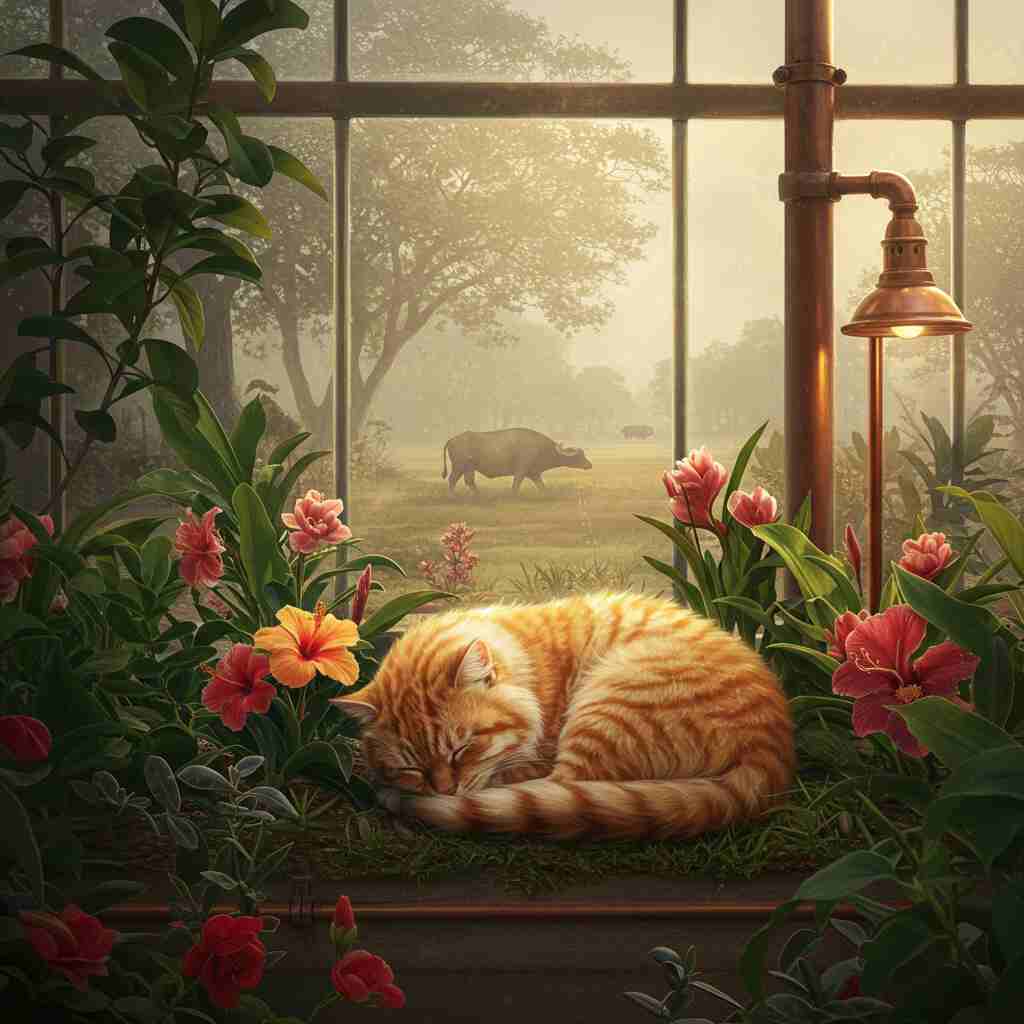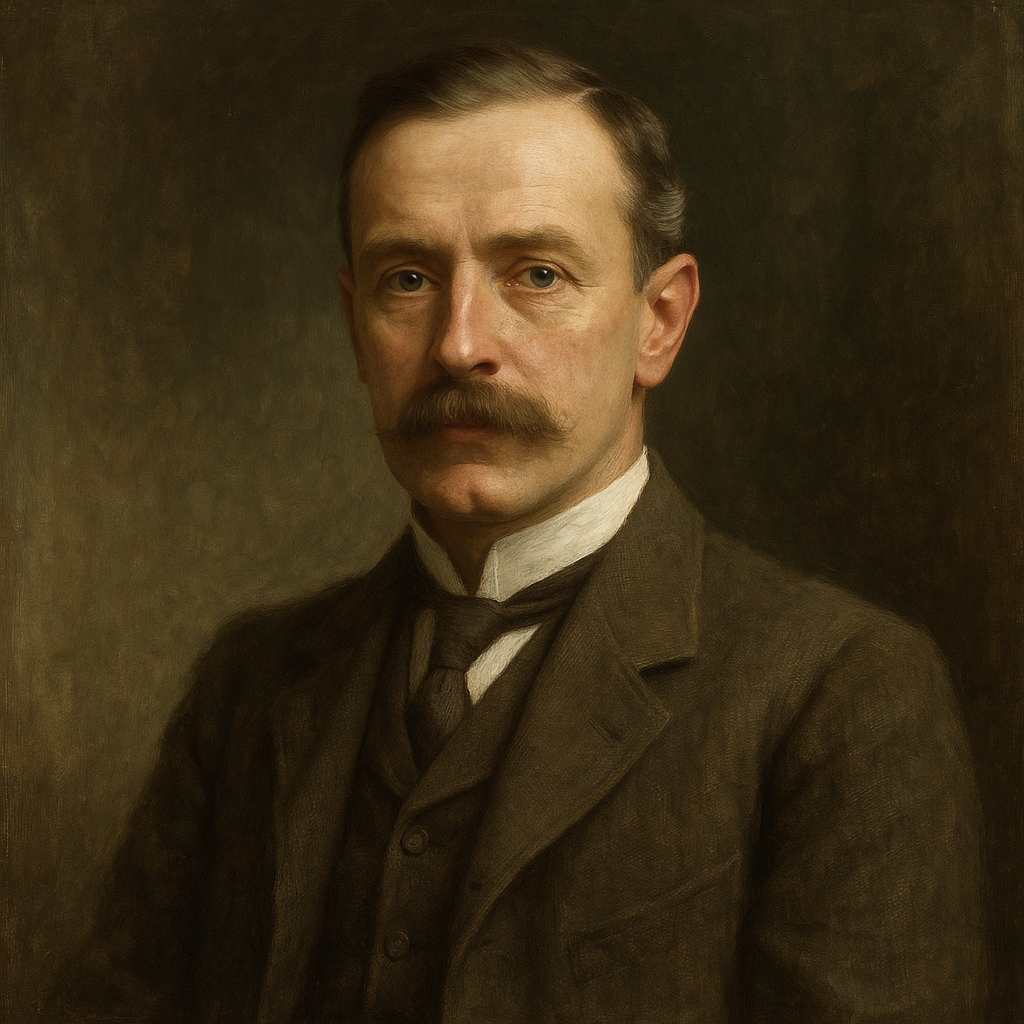The Gardener's Cat
Patrick Reginald Chalmers
1872 to 1942

The gardener's cat's called Mignonette,
She hates the cold, she hates the wet,
She sits among the hothouse flowers
And sleeps for hours and hours and hours.
She dreams she is a tiger fierce
With great majestic claws that pierce.
She sits by the hot-water pipes
And dreams about a coat of stripes;
And in her slumbers she will go
And stalk the sullen buffalo,
And when he roars across the brake
She does not wink, she does not wake.
It must be perfectly immense
To dream with such magnificence.
And pass the most inclement day
In this indeed stupendous way.
She dreams of India's sunny clime,
And only wakes at dinner-time,
And even then she does not stir
But waits till milk is brought to her.
How nice to be the gardener's cat.
She troubles not for mouse or rat,
But, when it's coming down in streams,
She sits among the flowers and dreams.
The gardener's cat would be the thing,
Her dreams are so encouraging;
She dreams that she's a tiger, yet
She's just a cat called Mignonette!
The moral's this, my little man —
Sleep 'neath life's hailstones when you can,
And if you're humble in estate,
Dream splendidly, at any rate!
Patrick Reginald Chalmers's The Gardener's Cat
Patrick Reginald Chalmers’ The Gardener's Cat is a charming and deceptively simple poem that invites readers into the world of Mignonette, a cat whose dreams transcend her humble domestic existence. On the surface, the poem appears to be a lighthearted depiction of a cat’s daily life, but beneath its playful tone lies a profound meditation on the power of imagination, the tension between reality and aspiration, and the universal human desire to escape the mundane. Written in the early 20th century, the poem reflects the cultural and historical context of its time while offering timeless insights into the human condition. Through its vivid imagery, gentle humor, and subtle moral, The Gardener's Cat resonates with readers on both an emotional and intellectual level.
Historical and Cultural Context
Patrick Reginald Chalmers (1872–1942) was a Scottish poet and writer whose works often celebrated the pastoral and the whimsical. His poetry frequently drew inspiration from nature, animals, and everyday life, reflecting the Romantic and Victorian traditions that emphasized the beauty of the natural world and the importance of imagination. The Gardener's Cat was written during a period of significant social and cultural change, as the world transitioned from the Victorian era to the modern age. The early 20th century was marked by rapid industrialization, urbanization, and the upheaval of World War I, which created a longing for simplicity and escapism among many people. Chalmers’ poem, with its idyllic setting and focus on the imaginative life of a cat, can be seen as a response to this cultural moment, offering readers a respite from the complexities of modern life.
The poem’s setting—a gardener’s hothouse filled with flowers and warmed by hot-water pipes—evokes a sense of tranquility and seclusion. This setting is significant, as it reflects the Victorian fascination with gardens as spaces of refuge and contemplation. The hothouse, in particular, symbolizes a controlled environment where beauty and life can flourish despite the harshness of the outside world. Mignonette, the gardener’s cat, becomes a symbol of contentment and imaginative freedom within this sheltered space, embodying the Victorian ideal of finding joy and meaning in small, everyday pleasures.
Literary Devices and Imagery
Chalmers employs a range of literary devices to bring Mignonette’s world to life and to convey the poem’s themes. The use of vivid imagery is particularly striking, as it allows readers to visualize the cat’s surroundings and her dreams with remarkable clarity. For example, the description of Mignonette sitting “among the hothouse flowers” and sleeping “for hours and hours and hours” creates a sense of warmth and comfort, while the repetition of “hours” emphasizes the leisurely pace of her life. This imagery contrasts sharply with the cold and wet weather outside, highlighting the hothouse as a sanctuary from the elements.
The poem’s central metaphor—Mignonette’s dreams of being a tiger—serves as a powerful symbol of aspiration and transformation. The tiger, with its “great majestic claws” and “coat of stripes,” represents strength, freedom, and wildness, qualities that stand in stark contrast to Mignonette’s domestic existence. Through this metaphor, Chalmers explores the tension between reality and imagination, suggesting that even the most humble beings can dream of greatness. The image of Mignonette stalking a “sullen buffalo” in her dreams further reinforces this theme, as it portrays her as a fearless and powerful predator, far removed from her actual role as a pampered house cat.
Chalmers also uses humor and irony to underscore the poem’s themes. The juxtaposition of Mignonette’s grand dreams with her mundane reality—she is, after all, “just a cat called Mignonette”—creates a sense of gentle irony that is both amusing and poignant. This irony is particularly evident in the final stanza, where the speaker reflects on the moral of the story: “Sleep ’neath life’s hailstones when you can, / And if you’re humble in estate, / Dream splendidly, at any rate!” Here, the poem’s playful tone gives way to a more serious message, encouraging readers to find solace and inspiration in their dreams, no matter how modest their circumstances.
Themes and Emotional Impact
At its core, The Gardener's Cat is a poem about the power of imagination and the importance of dreaming. Mignonette’s ability to transform herself into a tiger in her dreams serves as a metaphor for the human capacity to envision a better, more fulfilling life. This theme resonates deeply with readers, as it speaks to the universal desire to transcend the limitations of one’s circumstances and to find meaning and purpose in the face of adversity. The poem’s emphasis on dreaming as a form of escapism is particularly relevant in the context of the early 20th century, when many people were grappling with the challenges of industrialization, war, and social change.
Another key theme in the poem is the contrast between the domestic and the wild. Mignonette’s life in the hothouse is safe and comfortable, but it is also confined and predictable. Her dreams of being a tiger, on the other hand, represent freedom, adventure, and the untamed beauty of the natural world. This tension between domesticity and wildness reflects a broader cultural preoccupation with the relationship between civilization and nature, a theme that was central to much of the literature and art of the Victorian and Edwardian eras. By portraying Mignonette as a creature who straddles these two worlds, Chalmers invites readers to consider their own relationship to the natural world and to reflect on the ways in which they navigate the boundaries between safety and risk, comfort and adventure.
The poem’s emotional impact lies in its ability to evoke a sense of wonder and nostalgia. The image of Mignonette dreaming of “India’s sunny clime” while curled up by the hot-water pipes is both whimsical and poignant, as it captures the longing for distant lands and exotic adventures that lies at the heart of the human imagination. At the same time, the poem’s gentle humor and affectionate portrayal of Mignonette create a sense of warmth and intimacy that draws readers in and makes them feel connected to the cat and her world. This emotional resonance is further enhanced by the poem’s rhythmic language and musicality, which create a soothing and meditative effect.
Conclusion
In The Gardener's Cat, Patrick Reginald Chalmers has crafted a poem that is both delightful and profound. Through its vivid imagery, playful tone, and subtle moral, the poem explores themes of imagination, aspiration, and the tension between reality and dreams. At the same time, it offers a poignant reflection on the human condition, encouraging readers to find joy and meaning in the small, everyday moments of life. By situating Mignonette’s story within the idyllic setting of a gardener’s hothouse, Chalmers creates a world that is at once familiar and magical, inviting readers to escape into the realm of the imagination and to dream splendidly, no matter how humble their circumstances. In doing so, he reminds us of the enduring power of poetry to connect with people on an emotional level and to offer solace and inspiration in times of uncertainty and change.
This text was generated by AI and is for reference only. Learn more
Want to join the discussion? Reopen or create a unique username to comment. No personal details required!



Comments
No comments yet. Be the first to comment!